Dressed-For-Success Polenta with Herbed Oil
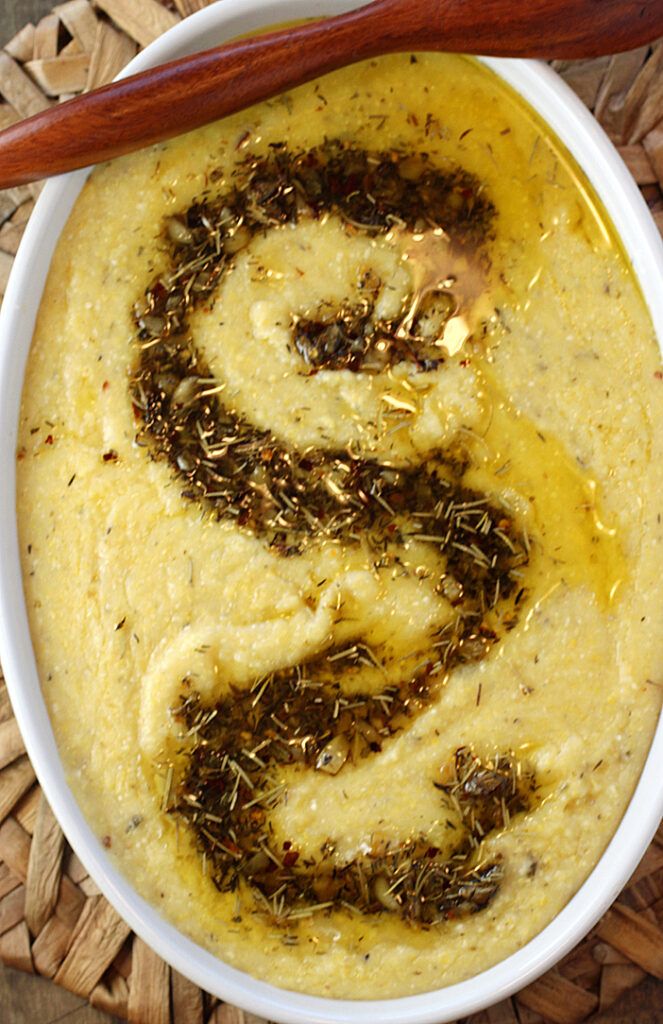
With gobs of butter and a veritable snowstorm of grated Parmigano.
That’s usually how I make and like my soft polenta.
But this recipe for “Polenta with Herbed Oil” offered another variation, one stripped of all that cheese, trading it instead for a copious amount of dried herbs found easily in my pantry that are steeped in a mixture of warmed butter and olive oil. In the process, it brought to the forefront more of that wonderful toasty corn taste.
This easy recipe is from “Cured” (Ten Speed Press), of which I received a review copy.
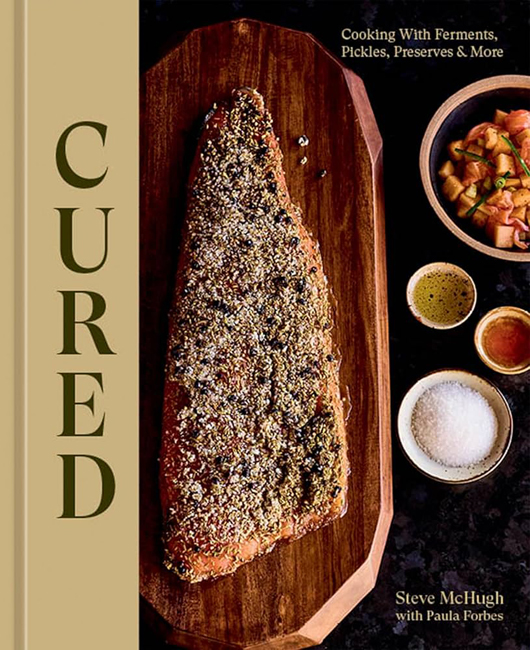
It was written by Steve McHugh, chef-owner of Cured in San Antonio, and Landrace in San Antonio; with assistance from Paula Forbes, a cookbook author, and former editor of Eater and Epicurious.
Normally, a cookbook with a title like this would leave me feeling a intimidated, as I imagined all manner of laborious recipes that lurked inside for sausages, pates, and charcuterie that I would frankly rather leave to the experts instead.
But this book is a pleasant surprise, offering up not only quite doable techniques for preserving your own ingredients with acid, ice, sugar, fat, fermentation, smoking, and drying, but also recipes for using store-bought ones.
McHugh widens the definition of curing, and in the process opens up our eyes and palates. Learn how to make his whole-grain mustard or buy a jar at the store to make “Split Pea Soup with Whole-Grain Mustard.” Learn to make his almond granola or use your favorite store-bought one to make “Roasted Squash with Granola” or “Granola Pie.” Learn how to infuse sugar with vanilla (one of the easiest techniques ever), then use it on “Sugar-Crusted Orange Cranberry Muffins.” And learn how to citrus-cure fish (like you how you would to make gravlax) to cook up “Cured Fish Noodle Casserole with Everything Bagel Topping.”
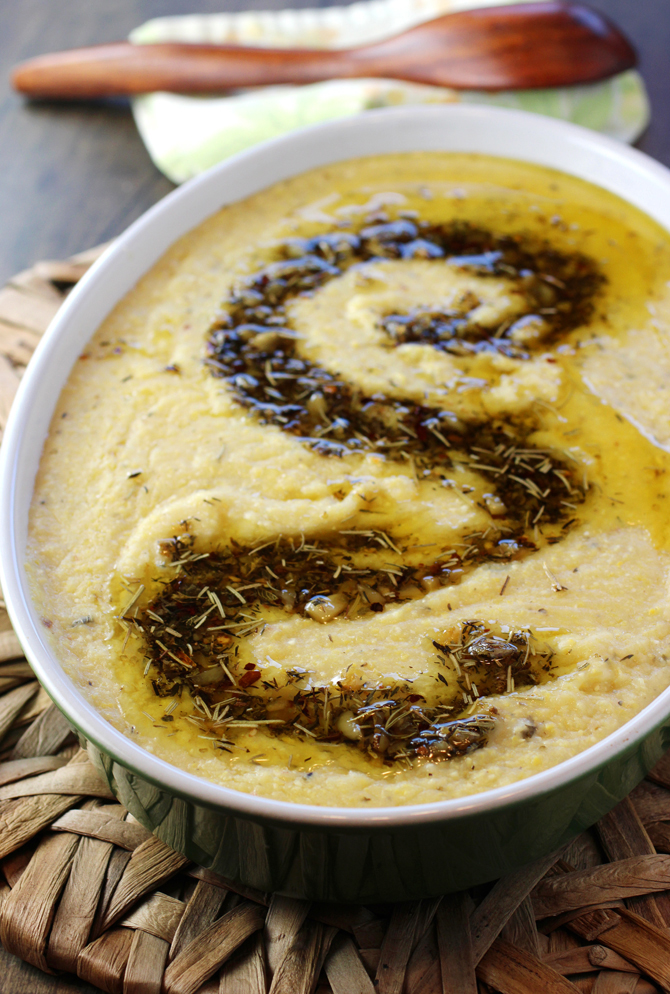
For this polenta, you can use a combination of herbs you already have in your pantry, such as oregano, basil, thyme, marjoram and rosemary. If you grow your own herbs or have leftover fresh ones after making a dish, McHugh suggests tying them up to hang them near a sunny window or laying them on a sheet pan overnight with the pilot light on in the oven to dry them — both techniques that require no heavy lifting.
Like all soft polenta, this one starts with cornmeal and a generous amount of water combined in a pot on the stovetop, then stirred, and stirred, and stirred — for about an hour until it’s creamy, tender, and has lost any of its raw taste.
In a separate small saucepan, heat olive oil and butter, then add garlic, the dried herbs, salt, and red pepper flakes. The heat will allow the flavors to really bloom and infuse the oil.
Stir half the herbed oil into the polenta, before transferring to a serving bowl. With the back of a spoon, create a decorative big swirl in the polenta, then spoon the rest of the herbed oil into the trough created. If your design starts to close up quickly, just create a portion of the swirl at a time, then fill it with the herbed oil, before continuing on to create the rest of it.
It’s a comforting dish with the creamy, soft polenta enriched here and there with the warm butter-olive oil, and suffused with a forest taste along with a hint of heat.
It would be perfect alongside roast chicken, grilled pork chops, sauteed shrimp or even Thanksgiving turkey. Or make it a foundation for sauteed mushrooms or roasted vegetables. Swap out dairy butter for vegan butter, and the entire dish easily turns vegan just like that, too.
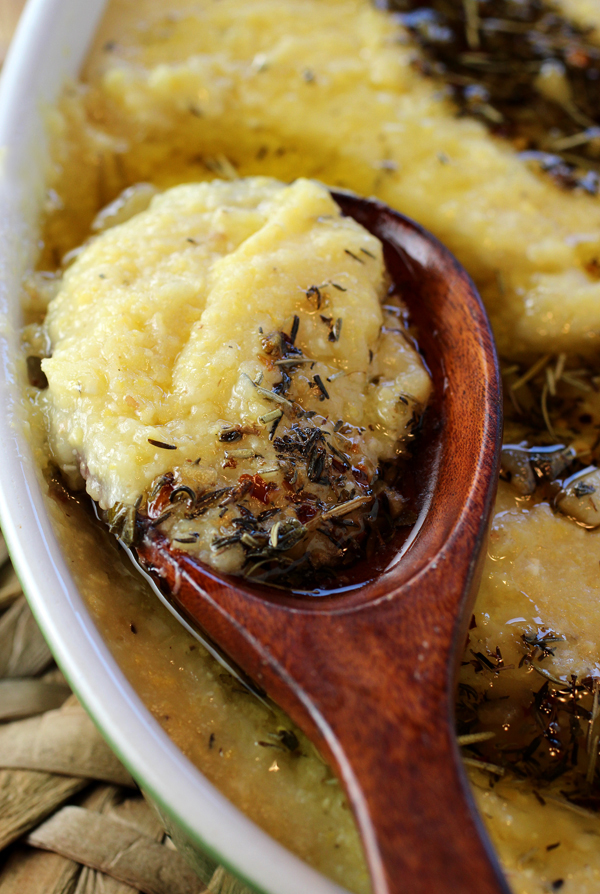
Polenta with Herbed Oil
(Serves 6)
2 teaspoons salt
1 1/2 cups yellow polenta (or coarse-ground cornmeal)
1/4 cup extra-virgin olive oil
1/4 cup (1/2 stick) unsalted butter
6 garlic cloves, roughly chopped
2 tablespoons dried herbs, such as oregano, basil, thyme, marjoram, rosemary, or a combination (see Note below)
1 teaspoon red pepper flakes
Combine 6 cups water and 1 teaspoon of the salt in a heavy bottomed pot and bring to a boil. Slowly whisk in the polenta. Cook, stirring, until slightly thickened, 1 to 2 minutes, then reduce the heat to low. Cover and cook, stirring periodically to prevent from sticking to the bottom of the pan, until the polenta is tender and thoroughly cooked, 45 minutes to 1 hour. (If the mixture becomes too thick during cooking, add 1/2 cup water or so to thin it.)
Meanwhile, heat the oil and butter in a small saucepan over medium-low heat until the butter is melted. Add the garlic and cook, stirring, until fragrant but not browned, about 5 minutes. Add the herbs and cook, stirring, for 2 minutes more. Add the red pepper flakes and remaining 1 teaspoon salt, stir for about 15 more seconds, then remove from the heat.
Add half the oil mixture to the polenta and stir to combine. Transfer to a serving bowl and use the back of a spoon to create a swirl-shaped indentation on top of the polenta. Carefully spoon the rest of the herbed oil over the top of the polenta, allowing it to settle into the swirl pattern. Serve.
Note: Herbs are easy to dry at home, as they dry out pretty quickly. So while you could dry herbs in a dehydrator, I often just tie up a bunch and hang it in a sunny window. If you have an oven with a pilot light, you can also spread out herbs on a sheet pan and leave them there overnight. (In the restaurant, we tie a kitchen towel to the oven door handle to remind everyone that something’s in the oven, so they don’t accidentally turn it on and scorch the herbs!)
From “Cured” by Steve McHugh with Paula Forbes
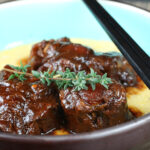
More Polenta Recipes to Enjoy: Preserved Lemon Polenta by Ming Tsai
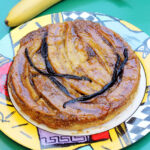
And: Banana Polenta Upside Down Cake
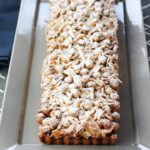
And: Polenta Cake with Brutti Ma Buoni Topping by Nancy Silverton
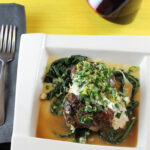
And: Pork Cheeks with Polenta, Mustard Cream and Horseradish Gremolata by Suzanne Goin

I make herbed oil all the time for bread dipping but I’ve never thought to use it as a sauce for polenta. Sounds great.